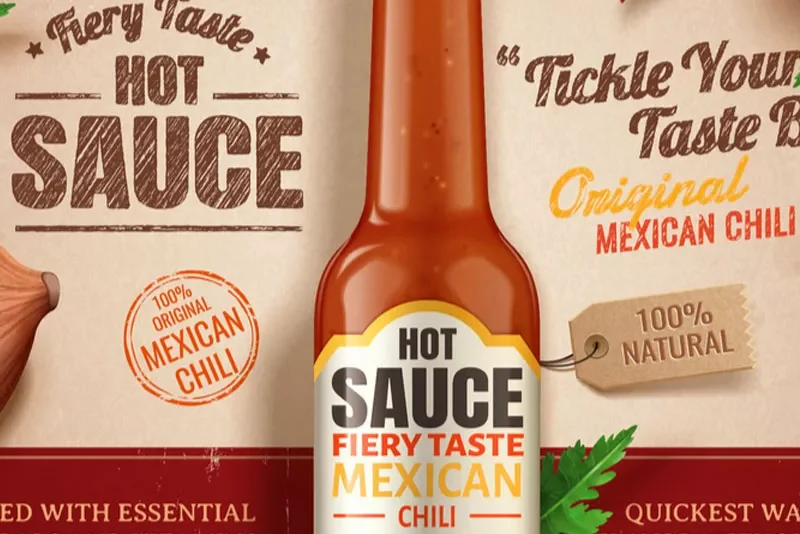Exploring the Fiery World of Mexican Hot Sauces

Mexican hot sauces are so popular around the world that there are challenges that have gone viral, unique recipes and unmatched flavors due to this extra additive.
In Mexico, Mexican hot sauces represent more than an extra to every meal, it is the love for the homeland, and the feeling of something original, especially knowing that they have been used since pre-Hispanic times.
In that sense, Mexican hot sauces are part of the tradition, customs, and of course, gastronomy in Mexico.
Going to the popular market in any Mexican city means an experience in search of the hottest chili peppers and hot peppers.
There is a huge variety according to the “spiciness” you want to generate in your dish or sauce; thus, the Mexican lives with this habit that no other country is able to match.
Some Mexican hot sauces are so famous that they travel around the world.
Hot sauces have a pre-Hispanic origin, and before the arrival of the Spaniards to the Mexican coasts, different cultures already elaborated chili grinding, a product that was mainly consumed by the elites, such as priests, nobles and kings, even being used in religious ceremonies.
Since then, chili grinding and subsequent sauces have remained a centerpiece of Mexican cuisine, even to this day.
A Mexican hot sauce is rich in spices used, often as a condiment, and in some cases as a dipping sauce.

The desire to eat Mexican hot sauce:
The spicy sensation of the sauce is caused by a substance known as capsaicin (active compound in hot peppers), piperine (found in black pepper) and allicin (present in raw garlic and onions).
By binding these substances together, they activate the sensation of acidity and heat in the ion channel on the nociceptors, which are the pain receptors.
Mexican hot sauces concentrate mainly on the flavor that intense spiciness provides.
Although some are really hot, the flavors of the chiles used are enhanced.
For example, the chipotle chile is very popular in Mexico for the preparation of hot sauces, giving them an unmistakable flavor.
Sauces are also made with fresh chiles, such as serrano, de árbol, habanero, manzano, etc.; or dried, such as ancho, guajillo, pasilla, de árbol, chiltepín, etc.
Some of the most common ingredients used to make Mexican hot sauces, besides chili, are: tomato, green tomato (tomatillo), garlic, onion, avocado, cilantro, xoconostle, peanut, and even fresh fruits.
History of Mexican Hot Sauce
Hearing hot sauce, immediately, in many nations of the world they get the idea of Mexican flavor.
And the fact is that Mexican hot sauce is part of the culture, it could be said that it is at the level of tequila, mariachis, among others.
And of course, as we have mentioned, the flavors in the different dishes are intensified with the special touch of Mexican hot sauce.
The origins of Mexican hot sauce date back to the Aztecs and Mayans who used tomatoes, chiles and pumpkin seeds to create the delicious mixture.
In fact, the conquering Spaniards documented Aztec culture and customs, including a condiment made from tomatoes, chiles and pumpkin seeds.
READ MORE: WHAT DOES MEXICO EAT FOR CHRISTMAS?
In the 1500s, a priest labeled this creation “salsa,” giving Mexican cuisine incredible popularity.
Mexico is one of the best exponents of spicy gastronomy as its soil produces more than 50 varieties of chili peppers.
The most popular chiles used to make Mexican hot sauce include jalapeño, serrano, guajillo, chipotle, chile de árbol, pasilla and habanero.
The most popular chiles used to make Mexican hot sauce include jalapeño, serrano, guajillo, chipotle, chile de árbol, pasilla and habanero.
The sauces and recipes created from these varieties enrich the national recipe book and are part of the collective imagination of any Mexican.
Most popular Mexican hot sauces:
Mexican hot sauce is so popular that, in the United States, especially in California and Texas, which were Mexican lands, they created a brand that is very popular.
And yes, we are referring to Tabasco sauce, which is not Mexican, but made in the United States in 1868.
The most popular Mexican hot sauce is La Valentina, which was created in 1960, and is the most established brand among Mexican hot sauces.
Mexican Hot Sauce: Varieties
Among the enormous variety of hot sauces that you should know, some stand out due to the different touch in their base recipe, thus, we have:
Salsa ranchera
This Mexican hot sauce is popular for its use in huevos rancheros or chilaquiles, a red sauce par excellence, in spite of the different versions it may have, a prevailing ingredient is the tomato.
Salsa Borracha:
This Mexican hot sauce is due to the fact that one of its typical ingredients is a typical Mexican alcohol: pulque.
Chipotle sauce
It is a Mexican hot sauce less spicy than others, it is made with chipotle, and there are even products, such as mayonnaise, that have included it as part of their presentations.
Green sauce
Green Mexican hot sauce is one of those that cannot be missing in any Mexican restaurant or fast food stand appetizer.
One way to enjoy it is to accompany mini cottage cheese gorditas with epazote.
Habanero sauce:
Habanero sauce is very popular, being one of the most recognized chiles throughout Mexico.
Habanero sauce may have different versions, but its ingredients include roasted habanero, sea salt, vinegar or sour orange juice.
Xcatic hot sauce
The xcatic chile is usually greenish yellow and elongated and in the state of Yucatan is a favorite to complement typical meals, as it goes well with salbutes, panuchos or broths, regardless of whether they are chicken or turkey.
It can be eaten fresh or roasted, being the second way one of the preferred ones.
Chamoy Sauce
Chamoy sauce may not be really hot, but its flavor is a mix between spicy and sweet, which makes it ideal for any member of the family.
It may not be the most traditional Mexican hot sauce, but that doesn’t change the fact that it is one of the favorite sauces among Mexicans.
READ HERE: PULQUE MEXICO: THE ANCIENT BEVERAGE OF THE GODS

Mexican hot sauce according to the region:
Mexican hot sauce can be a reflection of regional diversity, and each presentation offers unique flavors that reflect its geographical origin.
Thus, we have the Mexican hot sauce according to the region:
Jalisco: Molcajeteada sauce offers a smoky flavor; it combines roasted tomatillos, garlic, onions and hot chiles. It is ideal for meats.
Central Mexico: Guajillo chile sauce offers a sweet and smoky flavor, ideal to accompany meats and seafood.
Southern States: Mole amarillo includes more than 20 ingredients. It offers a sweet flavor ideal for chicken and turkey.
Mexican homemade sauces
Mexican homemade sauces are considered a pillar of the culinary tradition, since they reflect the tradition and gastronomic richness of the country.
They are recipes passed down from generation to generation, which are used to complement dishes and as a base for preparation. These sauces add flavor, spiciness and a refreshing contrast, making them essential elements of Mexican cuisine.
Mexican hot sauce: Some homemade recipes:
Salsa Roja:
Ingredients:
- 2 tomatoes
- 1 clove of garlic
- 1/4 onion
- 2-3 serrano or jalapeño peppers
Preparation:
- Roast the tomatoes, garlic, onion and chiles in a skillet without oil until charred.
- Place the ingredients in a molcajete or blender.
- Add salt to taste.
- Grind or blend to desired consistency.
Pico de Gallo:
Ingredients:
- 3 tomatoes
- 1/2 onion
- 2 serrano chiles
- Cilantro
Preparation:
- Finely chop the ingredients and mix in a bowl.
- Add lime juice and salt to taste
The benefits and harms of hot sauce:
As we have said, hot sauce stimulates the capsaicin receptor, it responds by sending signals to the brain that translate into the burning and stinging sensation in the oral mucosa.
And it is curious that, in low doses, it produces an increase in the production of endorphins, molecules responsible for the sensation of well-being. This is the first benefit.
When is it bad to eat spicy food?
In healthy people, excessive consumption of spicy foods can damage the mucosa of the gastrointestinal tract causing nausea, vomiting, abdominal pain, ulcers, diarrhea and hemorrhoids. Also, some studies have linked long-term abuse of capsaicin to stomach cancer.
Other benefits of eating Mexican hot sauce in low doses, stimulates gastric secretions, so the consumption of spicy foods in moderate amounts can help to promote digestion.
It exerts an anti-inflammatory action at arterial level and activates circulation.
It is a natural analgesic, since its pain-relieving action is due to the fact that it “tricks” the central nervous system by acting on the pain receptors.
It is an activator of energy metabolism, as it can activate one of the key enzymes in the regulation of metabolism and energy control.
More, however, has its detriments, and could originate:
- Gastroduodenal ulcer
- Gastritis
- Irritable bowel syndrome
- Gastroesophageal reflux
- Hemorrhoids
- Liver problems.






